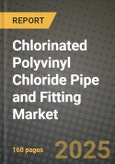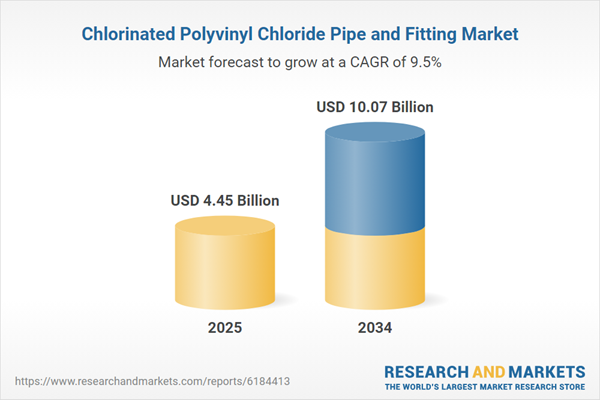Chlorinated Polyvinyl Chloride Pipe and Fitting Market
Chlorinated Polyvinyl Chloride (CPVC) pipes and fittings serve hot and cold potable water, fire-protection mains, and a range of light-industrial fluid handling needs where temperature resistance and corrosion performance are critical. In residential and commercial plumbing, CPVC is valued for dimensional stability, long service life with chlorinated water, and straightforward solvent-cement installation that shortens project timelines. Fire sprinkler applications benefit from CPVC’s listings and ease of retrofitting in occupied buildings, while industrial users adopt schedule-rated systems for acids, alkalis, and brine lines. Recent trends include wider code acceptance, low-lead and low-VOC formulations, BIM-ready product libraries, and installation accessories that reduce joints and labor. On the demand side, urban housing programs, hotel and healthcare capex, and retrofits for water quality and fire safety underpin steady replacement cycles. On the supply side, integrated resin-to-compound ecosystems, regional compounding hubs, and brand-to-brand technology licensing shape the competitive landscape. CPVC competes with copper, PEX, multilayer composites, stainless steel, and PP-R; winning plays center on life-cycle cost, chemical compatibility, pressure-temperature envelopes, and contractor familiarity. Manufacturers differentiate through proprietary compounds, fire-protection listings, antimicrobial or scaling-resistant surfaces, solvent cements with faster set times, and channel partnerships with MEP contractors and distributors. Across end-uses - residential plumbing, commercial complexes, institutional buildings, light industrial plants, and shipboard/HVAC utility lines - the market’s momentum is reinforced by tightening building codes, rising water treatment standards, and the need for reliable, low-maintenance piping systems.Chlorinated Polyvinyl Chloride Pipe and Fitting Market Key Insights
- Code acceptance & compliance: Broader recognition in plumbing and fire codes, plus approvals for potable water and fire protection, reduce specification barriers. Contractors gain confidence from standardized installation procedures and solvent cements, shrinking inspection issues and rework on complex projects.
- Residential retrofit engine: Aging premises and water-quality concerns drive replacement of galvanized steel or failed polymers with CPVC in multifamily and single-family housing. Quick, low-noise installation and compatible transition fittings simplify change-outs without extensive wall demolition.
- Commercial & institutional demand: Hospitals, hotels, schools, and data centers prefer predictable hydraulics, corrosion resistance, and compatibility with treated water. CPVC’s lighter weight reduces structural loads and cranage, while fire-rated systems enable phased renovations in live facilities.
- Fire sprinkler expansion: Listing-compliant CPVC gains share in light-hazard occupancies and residential sprinklers. Ease of threading through tight plenums and low thermal conductivity reduce condensation risks, supporting adoption in retrofits and new builds alike.
- Industrial niches: Chemical process skids, microelectronics utilities, and water treatment plants leverage CPVC for acids, alkalis, and saline streams. Schedule-rated pipe and fittings with heat-deflection margins enable reliable service where PP-R or PVC may fall short.
- Competing materials landscape: Copper price volatility, PEX oxygen-barrier requirements, and PP-R fusion skill needs shape material selection. CPVC wins where water chemistry is aggressive, temperatures are elevated, and contractors value solvent-weld speed over fusion tooling.
- Product & system innovation: Advances include higher-performance compounds, low-odor cements with rapid set, push-fit compatible transitions, and fire-protection components optimized for hydraulic calculations. BIM content and design tools streamline takeoffs and clash detection.
- Quality & warranty signaling: Brand ecosystems pair resins, compounds, pipe, fittings, and cements under unified warranties. Training, installer certification, and audit trails mitigate stress-cracking from incompatible chemicals and ensure joint integrity over time.
- Supply chain & localization: Regional compounding, licensing partnerships, and captive resin capacity buffer logistics shocks and lead times. Local code testing and distributor education accelerate specifications in secondary cities and tier-two industrial parks.
- Sustainability & compliance: Lead-free stabilizers, low-VOC adhesives, and documentation for green building certifications support ESG goals. Life-cycle assessments emphasize reduced corrosion failures, fewer leaks, and lower embodied energy versus metals in comparable duty.
Chlorinated Polyvinyl Chloride Pipe and Fitting Market Reginal Analysis
North America
Adoption is reinforced by mature code frameworks in plumbing and fire protection, deep distributor networks, and strong retrofit cycles in multifamily and institutional buildings. CPVC benefits from contractor familiarity, solvent-cement speed, and consistent potable-water approvals. Competition from PEX in low-temperature domestic loops remains, but CPVC holds where temperature and water chemistry are demanding. Manufacturer training programs, long warranties, and BIM libraries further ease specification in large commercial and healthcare projects.Europe
Penetration varies by country given the strong presence of PP-R, multilayer composites, and copper in many markets. CPVC finds traction in fire protection for hotels and care facilities and in industrial utilities where chemical resistance and temperature stability are decisive. REACH-aligned additives and documentation support compliance, while localized testing and installer education address specification conservatism. Growth levers include hospitality retrofits, district renovations, and small industrial upgrades seeking corrosion-resistant alternatives.Asia-Pacific
Demand is propelled by housing programs, high-rise commercial development, and expanding light manufacturing, with strong momentum in South Asia and parts of Southeast Asia. In plumbing, CPVC competes against PP-R and metals but gains where hot-water reliability and treated-water compatibility are priorities. Industrial users adopt schedule-rated systems in chemicals and water treatment. Regional compounding hubs and brand partnerships enable quick lead times, localized training, and tailored product assortments for varying codes and construction practices.Middle East & Africa
Urbanization, hospitality builds, and stringent fire-safety requirements in the Gulf bolster adoption for both domestic water and sprinkler lines. CPVC’s corrosion resistance suits desalinated and treated waters common in the region. Procurement decisions emphasize total installed cost, heat-exposure management, and contractor training to ensure joint integrity under high ambient temperatures. In Africa, opportunities center on commercial nodes and industrial parks where reliable, low-maintenance piping is prioritized.South & Central America
CPVC benefits from commercial and residential renovation cycles, especially where water chemistry challenges and legacy metal systems drive failures. Local compounding and distributor footprints improve availability and project service levels. In mixed-material projects, CPVC’s transition fittings and solvent-cemented joints reduce installation times and skilled labor needs. Fire-protection upgrades in hospitality and retail, plus light-industrial water treatment lines, provide steady specification pathways across key metropolitan areas.Chlorinated Polyvinyl Chloride Pipe and Fitting Market Segmentation
By Type
- Pipes
- Fitting
By End-User
- Industrial
- Residential
- Commercial
Key Market players
Astral Limited, Ashirvad Pipes (Aliaxis), Supreme Industries, Prince Pipes and Fittings, Finolex Industries, Apollo Pipes, Ajay Pipes, China Lesso Group, ERA (Guangdong ERA), Zhejiang Weixing New Building Materials, NIBCO, Charlotte Pipe and Foundry, IPEX (Aliaxis), GF Piping Systems, Spears ManufacturingChlorinated Polyvinyl Chloride Pipe and Fitting Market Analytics
The report employs rigorous tools, including Porter’s Five Forces, value chain mapping, and scenario-based modelling, to assess supply-demand dynamics. Cross-sector influences from parent, derived, and substitute markets are evaluated to identify risks and opportunities. Trade and pricing analytics provide an up-to-date view of international flows, including leading exporters, importers, and regional price trends.Macroeconomic indicators, policy frameworks such as carbon pricing and energy security strategies, and evolving consumer behaviour are considered in forecasting scenarios. Recent deal flows, partnerships, and technology innovations are incorporated to assess their impact on future market performance.
Chlorinated Polyvinyl Chloride Pipe and Fitting Market Competitive Intelligence
The competitive landscape is mapped through proprietary frameworks, profiling leading companies with details on business models, product portfolios, financial performance, and strategic initiatives. Key developments such as mergers & acquisitions, technology collaborations, investment inflows, and regional expansions are analyzed for their competitive impact. The report also identifies emerging players and innovative startups contributing to market disruption.Regional insights highlight the most promising investment destinations, regulatory landscapes, and evolving partnerships across energy and industrial corridors.
Countries Covered
- North America - Chlorinated Polyvinyl Chloride Pipe and Fitting market data and outlook to 2034
- United States
- Canada
- Mexico
- Europe - Chlorinated Polyvinyl Chloride Pipe and Fitting market data and outlook to 2034
- Germany
- United Kingdom
- France
- Italy
- Spain
- BeNeLux
- Russia
- Sweden
- Asia-Pacific - Chlorinated Polyvinyl Chloride Pipe and Fitting market data and outlook to 2034
- China
- Japan
- India
- South Korea
- Australia
- Indonesia
- Malaysia
- Vietnam
- Middle East and Africa - Chlorinated Polyvinyl Chloride Pipe and Fitting market data and outlook to 2034
- Saudi Arabia
- South Africa
- Iran
- UAE
- Egypt
- South and Central America - Chlorinated Polyvinyl Chloride Pipe and Fitting market data and outlook to 2034
- Brazil
- Argentina
- Chile
- Peru
Research Methodology
This study combines primary inputs from industry experts across the Chlorinated Polyvinyl Chloride Pipe and Fitting value chain with secondary data from associations, government publications, trade databases, and company disclosures. Proprietary modeling techniques, including data triangulation, statistical correlation, and scenario planning, are applied to deliver reliable market sizing and forecasting.Key Questions Addressed
- What is the current and forecast market size of the Chlorinated Polyvinyl Chloride Pipe and Fitting industry at global, regional, and country levels?
- Which types, applications, and technologies present the highest growth potential?
- How are supply chains adapting to geopolitical and economic shocks?
- What role do policy frameworks, trade flows, and sustainability targets play in shaping demand?
- Who are the leading players, and how are their strategies evolving in the face of global uncertainty?
- Which regional “hotspots” and customer segments will outpace the market, and what go-to-market and partnership models best support entry and expansion?
- Where are the most investable opportunities - across technology roadmaps, sustainability-linked innovation, and M&A - and what is the best segment to invest over the next 3-5 years?
Your Key Takeaways from the Chlorinated Polyvinyl Chloride Pipe and Fitting Market Report
- Global Chlorinated Polyvinyl Chloride Pipe and Fitting market size and growth projections (CAGR), 2024-2034
- Impact of Russia-Ukraine, Israel-Palestine, and Hamas conflicts on Chlorinated Polyvinyl Chloride Pipe and Fitting trade, costs, and supply chains
- Chlorinated Polyvinyl Chloride Pipe and Fitting market size, share, and outlook across 5 regions and 27 countries, 2023-2034
- Chlorinated Polyvinyl Chloride Pipe and Fitting market size, CAGR, and market share of key products, applications, and end-user verticals, 2023-2034
- Short- and long-term Chlorinated Polyvinyl Chloride Pipe and Fitting market trends, drivers, restraints, and opportunities
- Porter’s Five Forces analysis, technological developments, and Chlorinated Polyvinyl Chloride Pipe and Fitting supply chain analysis
- Chlorinated Polyvinyl Chloride Pipe and Fitting trade analysis, Chlorinated Polyvinyl Chloride Pipe and Fitting market price analysis, and Chlorinated Polyvinyl Chloride Pipe and Fitting supply/demand dynamics
- Profiles of 5 leading companies - overview, key strategies, financials, and products
- Latest Chlorinated Polyvinyl Chloride Pipe and Fitting market news and developments
Additional Support
With the purchase of this report, you will receive:- An updated PDF report and an MS Excel data workbook containing all market tables and figures for easy analysis.
- 7-day post-sale analyst support for clarifications and in-scope supplementary data, ensuring the deliverable aligns precisely with your requirements.
- Complimentary report update to incorporate the latest available data and the impact of recent market developments.
This product will be delivered within 1-3 business days.
Table of Contents
Companies Mentioned
- Astral Limited
- Ashirvad Pipes (Aliaxis)
- Supreme Industries
- Prince Pipes and Fittings
- Finolex Industries
- Apollo Pipes
- Ajay Pipes
- China Lesso Group
- ERA (Guangdong ERA)
- Zhejiang Weixing New Building Materials
- NIBCO
- Charlotte Pipe and Foundry
- IPEX (Aliaxis)
- GF Piping Systems
- Spears Manufacturing
Table Information
| Report Attribute | Details |
|---|---|
| No. of Pages | 160 |
| Published | November 2025 |
| Forecast Period | 2025 - 2034 |
| Estimated Market Value ( USD | $ 4.45 Billion |
| Forecasted Market Value ( USD | $ 10.07 Billion |
| Compound Annual Growth Rate | 9.5% |
| Regions Covered | Global |
| No. of Companies Mentioned | 15 |









